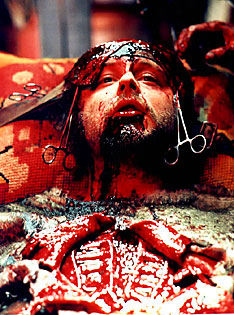 |
|
Photo courtesy of Lions Gate Films
|
Gore movie fans take note: White Zombie frontman Rob Zombie's directorial debut, "House of 1,000 Corpses," comes out tomorrow.
|
|
By Mark Betancourt
Arizona Daily Wildcat
Thursday April 17, 2003
Rob Zombie, known for his sadistically dark "white-trash metal," has made a movie. One would think immersing oneself in a giant projected version of Zombie's mind, out of which have crawled such songs as "Demonoid Phenomenon" and "Dragula," would be a disturbing, sickening, terrifying experience. And it is.
But Zombie, however freakish he seems, knows his stuff. There is an art to making horror films that requires as much understanding of the human psyche as of cameras and celluloid, and Zombie has obviously done some heavy studying.
The opening sequence of "House of 1,000 Corpses" could be the intro to a hip documentary about freak shows and the history of creeping people out. Shot on video, this sequence depicts a commercial for Captain Spaulding's house of horrors/fried chicken stand and sets the tone of grotesque humor mixed with repulsive imagery that pervades the film from then on.
The opening credits then begin to roll as vague images of murder, bondage, and generally unsettling wheat fields flash and convulse on the screen. This is already not your average horror film.
Then the two dorky boys with their hot girlfriends drive up to Captain Spaulding's and decide to take a closer look. Yep, you can see where this is going. But that's okay, because for some unholy reason we trust Zombie to take us somewhere interesting with this clichÄd opening. He does take us somewhere interesting, but we should never, ever have trusted him.
The kids end up in this awful house full of physically, socially and emotionally deformed hicks who are all related to each other and enjoy torturing (really, really torturing) our little protagonists. Things get worse, much worse.
One of the best things about this film is the way Zombie continually returns to those brief montages of pure imagery at key intervals, almost like the spinning head of Inspector Gadget between scenes of his cartoon show, but with naked women and blood and guts and torture.
In these short intervals, Zombie experiments with crazy film techniques, altering color and using effects like solarization (this makes the image look kind of like a film negative) to make the images seem even more alien. This is a purely expressionistic touch, and lends a great deal of aesthetic appeal (if either of those words are appropriate) to an otherwise pure gore-horror movie.
This film is smarter than it looks. You're grossed out, but if you take a closer look you'll see that Zombie is behind the scenes, pulling some very Freudian strings: The sexually jealous girl dies first. The remaining one loves only her father, and in one of the creepiest scenes his face Ě well, never mind. The mother of the family of sickos is disgusting and a whore, while the daughter is really hot and a whore but likes to torture cheerleaders. It's all very interesting.
Zombie's real triumph, though, is harnessing the power of the rural gothic, our collective fear of the sticks and the people who live there. Throughout the film the psychotic hicks are always asking, "Are you making fun of us country folk?"
And yes, there's something appalling about the way Grandpa Sicko, in his filthy overalls, eats his TV dinner. Their house in the backwoods is the most terrible place to end up, because ¸ and this is the worst part ¸ there's no phone there.
In one of the most openly symbolic scenes in the film, the final girl tries to escape the Sickos while wearing one of the bunny costume they've put on her and her boyfriend. "Humans ain't nothin' but rabbits," says the lead Sicko. "Run, rabbit run!"
Then, deep in the terrible caverns beneath the Sicko estate, she sees someone wearing a bunny suit approach her out of the shadows. She thinks it's her boyfriend, but everyone in the theater knows it isn't. His face comes into the pale light so slowly, so silently, that this moment becomes more horrifying than any other in this incredibly gory film. This is in fact a perfect example of Freud's theory of the uncanny, which states that people are most afraid when things that are familiar to them are made to seem unfamiliar. In our case, the bunny suit is middle class suburbia, and the horror of this moment is knowing what un-civilization lies outside our cities and deep within our hearts, lurking to remind us of our sexual deviance, of our lust for violence, of our enjoyment of paying to see both play out before our eyes.
In the theater, watching our final girl scream her head off, we are also wearing bunny suits. Zombie ¸ and our redneck past ¸ are chasing us.

